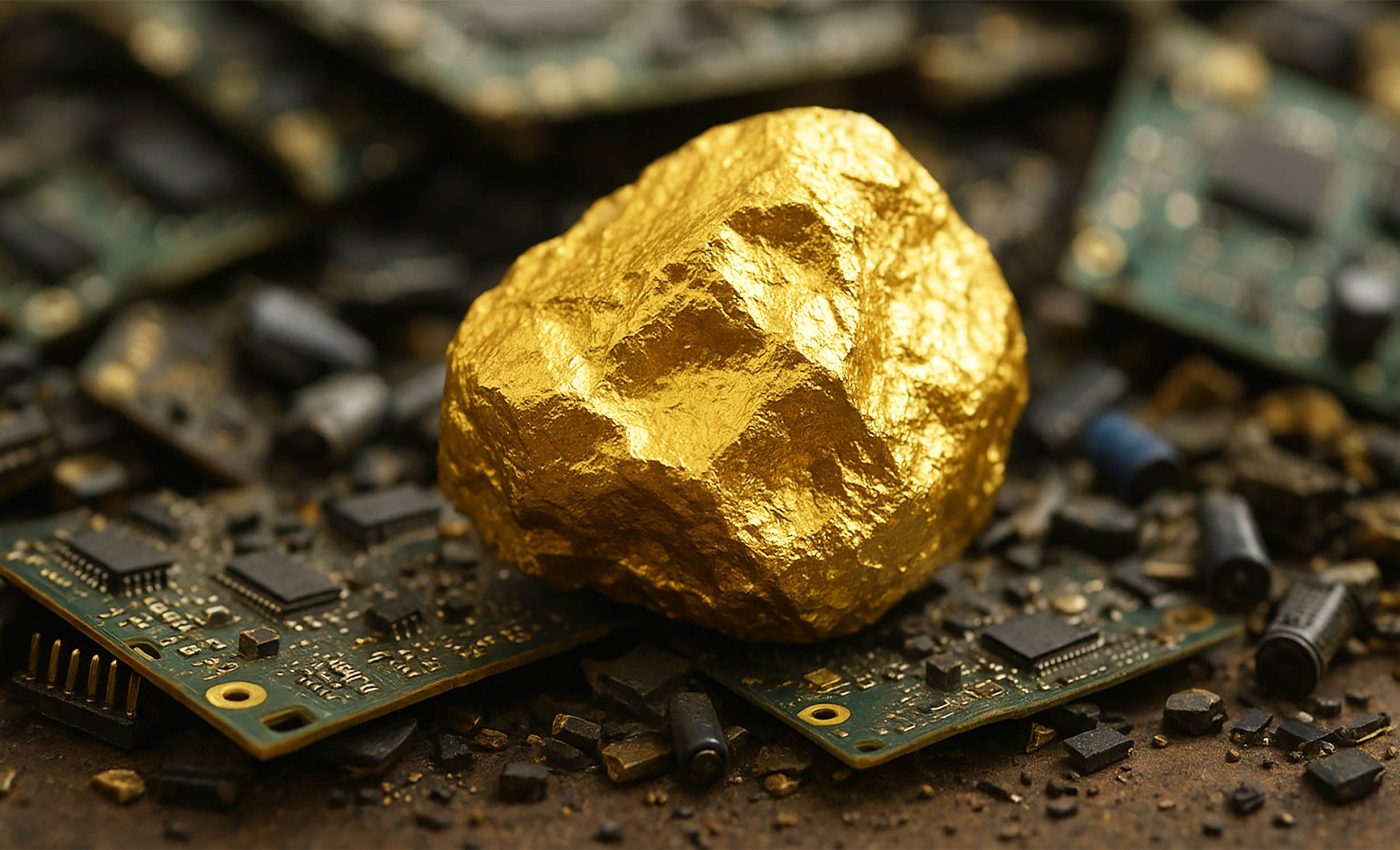
Invention turns e-waste into 22-carat gold nuggets instead of toxic trash
The thin line of gold behind every tap, swipe, and click on our electronic devices rarely enters daily conversation, yet the metal keeps digital life running, then eventually turn into landfills full of toxic e-waste.
From the contacts in a phone jack to the chips inside a smartwatch, gold moves electrons smoothly and shrugs off corrosion.
Mining more, however, blasts mountains, drains rivers, and spews carbon. With the global appetite for electronics still climbing, attention has turned to the growing junkyard of cast‑off gadgets.
E‑waste is now the quickest‑rising waste stream on the planet – roughly 63 million short tons in 2024 according to United Nations estimates – and only a small share gets recycled in certified facilities.
Most of our old electronics end up in landfills or backyard workshops, which then leak metals into the groundwater, creating toxic brews. A cleaner strategy is to reclaim precious metals safely before our devices make their way into the garbage heaps.
Cheese, e-waste, and gold
A research team is now working to change that script. Professor Raffaele Mezzenga at ETH Zurich and senior scientist Mohammad Peydayesh assembled colleagues in search of a simpler tool than acid vats or cyanide baths. Their unlikely inspiration bubbles up in cheese factories.
Cheese makers separate curds from whey, leaving behind nearly nine pounds of watery by‑product for every pound of cheddar. Whey is rich in proteins that twist into hair‑thin amyloid fibrils when warmed in acid.
The Zurich group realized those fibrils could be coaxed into a feather‑light sponge that prefers gold over the other metals lurking in shredded phones and laptops.
Adding a cheesy twist to golden e-waste
The researchers stirred the fibrils into a gel, then dried it into an aerogel – think Styrofoam’s airiness on a nanoscale. Microscopic pores criss‑cross the material, offering miles of surface area inside a crumb‑sized cube.
When a slice of this sponge meets a beaker filled with dissolved circuit boards, gold ions rush toward the proteins and cling tightly.

Early trials showed the aerogel collecting a far higher share of gold than plastic resins that recyclers often use. Better yet, the process skips noxious solvents.
Water, moderate heat, and the natural chemistry of protein do the heavy lifting, which slashes both hazard and cost.
Aerogel and a protein sponge
For a head‑to‑head laboratory test, the team stripped metal parts from twenty discarded computer motherboards, dissolved them in acid, and dropped in a fingernail‑sized piece of aerogel.
Copper, nickel, and cobalt swirled in the brew, yet gold ions settled on the sponge far more efficiently. After a short soak, the solution cleared, signaling that most of the precious metal had left the liquid.
Numbers tell the story. The sponge drew out gold that was about 90.8 percent pure – close to 22‑karat jewelry – on its first pass. Competing adsorbents usually require extra purification steps to reach similar purity.
From e-waste ions to gold nuggets
Pulling ions from solution is useful; turning them back into solid metal is crucial. The Zurich group warmed the loaded sponge until the gold ions shed their charge and merged into shimmering flakes.
Heating continued until the flakes fused into a nugget weighing roughly 450 milligrams. Chemical analysis showed the lump was 91 percent gold and 9 percent copper, again hitting the mark for 22 carats.
This step also freed the protein skeleton. Burned away under controlled heat, the whey‑derived matrix leaves no synthetic residue, easing cleanup. Conventional resin beds cannot claim the same neat exit.

Recycling lives or dies on the balance sheet. Here the math looks encouraging.
Procurement and energy costs for the entire operation are about fifty times lower than the market value of the gold retrieved. Even after accounting for labor and overhead, that margin hints at solid profit for commercial recyclers.
Lower operating costs open doors for smaller regional plants. Instead of shipping obsolete electronics overseas, communities could process them nearby, cutting transportation emissions and keeping revenue local.
e-Waste has more than just gold
Gold steals headlines, yet the technique need not stop there. By tweaking pH or tailoring the protein structure, the same sort of sponge could sort copper, cobalt, or palladium – metals vital for batteries and sensors.
The team is already experimenting with pea‑protein waste from plant‑based milk production and collagen from fish scales. Success would guard against supply bottlenecks tied to a single dairy stream.
E‑waste is not the only target. Industrial rinse water from microchip fabrication and gold‑plating shops also carries trace metals worth reclaiming. A modular protein sponge could slip into those lines, trimming costs and curbing runoff.
Taking the next steps
“The fact I love the most is that we’re using a food industry byproduct to obtain gold from electronic waste,” Mezzenga says. In a very real sense, the method transforms two waste products into gold. “You can’t get much more sustainable than that!”
If pilot projects scale as hoped, tomorrow’s recycling centers may sit beside creameries and food processors, quietly turning yesterday’s whey and last decade’s gadgets into tomorrow’s circuit traces.
The approach will not halt mining overnight, but every recovered ounce delays a blast, a slurry pond, or a diesel haul truck.
That shift, multiplied across millions of phones and laptops, offers a straightforward path toward lighter footprints and longer‑lived resources – no new mountains required.
The full study was published in the journal Advanced Materials.
—–
Like what you read? Subscribe to our newsletter for engaging articles, exclusive content, and the latest updates.
Check us out on EarthSnap, a free app brought to you by Eric Ralls and Earth.com.
—–













